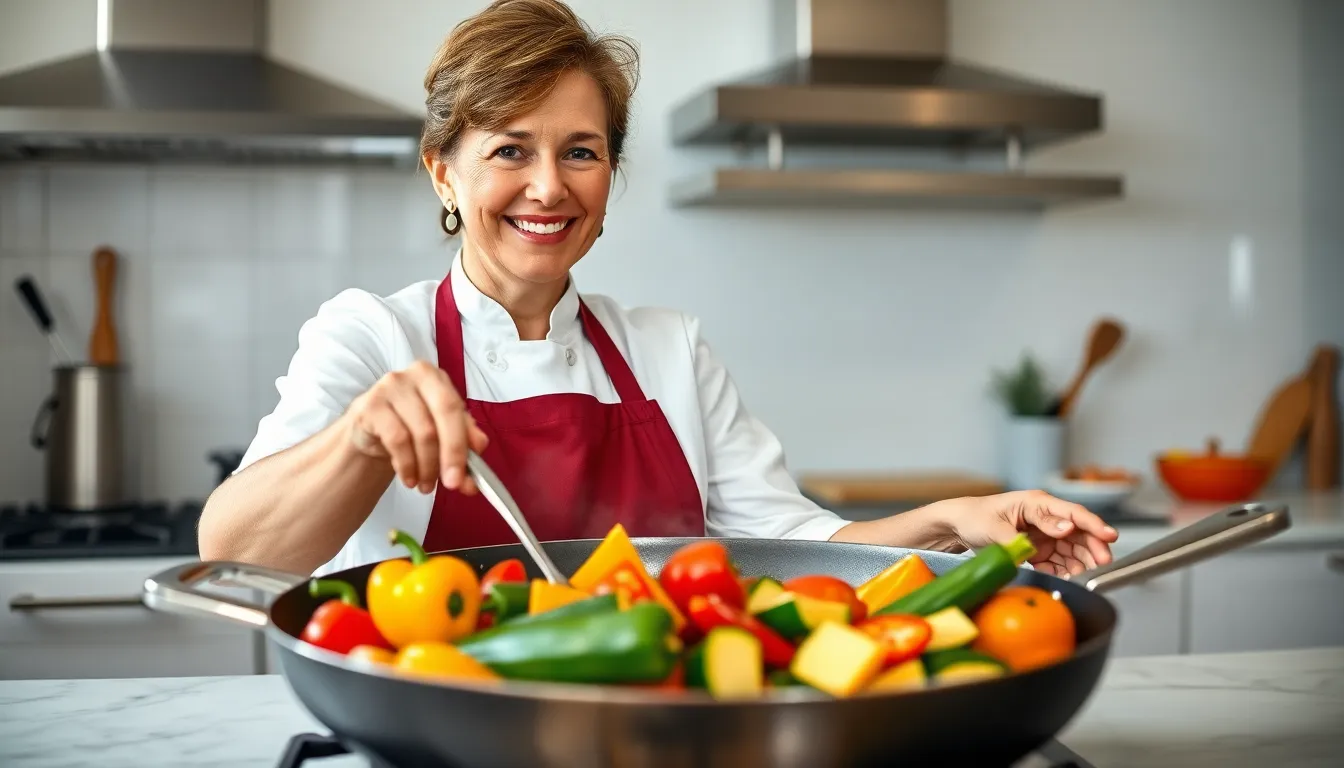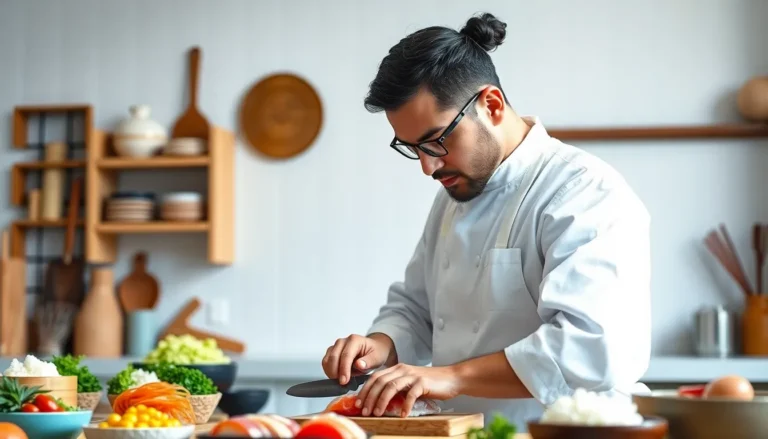
Italian Cooking Techniques: Unlock the Secrets to Delicious Authentic Recipes
Italian cooking techniques are like a secret handshake among chefs. They blend tradition with a dash of creativity, turning simple ingredients into mouthwatering masterpieces. Whether it’s the art of pasta-making that makes one feel like a culinary magician or the slow-roasting methods that transform vegetables into gloriously caramelized delights, these techniques have a way of making even the most novice cook feel like a pro.
Italian Cooking Techniques
Italian cooking techniques blend tradition with creativity. Chefs elevate simple ingredients using methods that emphasize flavor and technique. Pasta-making stands out as a fundamental skill. Making fresh pasta involves mixing flour and eggs, then kneading the dough into a smooth consistency. Once formed, chefs can shape it into various styles like fettuccine or ravioli.
Slow-roasting techniques enhance the natural flavors of meats and vegetables. This method focuses on low, consistent heat, allowing the ingredients to develop depth and tenderness. Roasting a whole chicken with herbs and garlic exemplifies this approach, creating a dish bursting with aroma.
Grilling plays a prominent role in Italian cuisine as well. Many dishes highlight seasonal vegetables and meats cooked over an open flame, imparting a smoky char. Grilled eggplant, drizzled with olive oil, showcases the simplicity and taste of fresh produce.
Another essential technique is sautéing. This quick cooking method requires minimal oil, retaining the nutrients and vibrant colors of the ingredients. Sautéing garlic and spinach results in a versatile side dish that complements a variety of main courses.
Simmering also deserves mention. This gentle cooking process allows flavors to meld in soups and sauces. For example, simmering tomatoes with basil for marinara sauce forms the base for countless Italian dishes.
Finally, layering flavors through seasoning is crucial. Using high-quality olive oil, sea salt, and fresh herbs elevates every Italian dish. Mastering these cooking techniques enables anyone to create authentic Italian meals from scratch.
Essential Techniques In Italian Cooking

Italian cooking techniques emphasize simplicity and flavor. Mastering these methods enhances understanding of authentic dishes.
Sautéing And Stir-Frying
Sautéing forms a staple in Italian kitchens, highlighting the use of olive oil and garlic as a base. Quick cooking retains the vibrant colors and nutrients of vegetables, like bell peppers and zucchini. Ingredients cook over medium-high heat, promoting a delightful caramelization that enhances flavors. Stir-frying can adapt to various ingredients, making it versatile for seasonal produce. Fresh herbs often complement the sautéed dishes and can be added just before serving, preserving their aroma. Utilizing high-quality olive oil ensures a rich flavor in every bite.
Braising And Stewing
Braising provides a method for tenderizing tougher cuts of meat, making it ideal for hearty dishes like osso buco. Slow cooking in broth or wine allows flavors to meld and develop over time. Stewing also showcases vegetables, creating rich, comforting meals such as minestrone. The long, low heat breaks down connective tissues, resulting in fork-tender consistency. This technique highlights regional ingredients, allowing for creativity and adaptation based on available produce. Combining herbs and spices during cooking layers flavors, offering a robust finish guaranteed to satisfy any palate.
Regional Variations In Italian Cooking Techniques
Italian cuisine showcases diverse techniques across its regions, each uniquely reflecting local ingredients and traditions. Northern and Southern Italy exhibit distinct culinary approaches, enhancing the flavors and textures of their dishes.
Northern Italian Techniques
Northern Italy emphasizes creamy sauces and rich flavors. Risotto exemplifies this, where Arborio rice absorbs broth gradually, resulting in a creamy consistency. Braising takes center stage when cooking hearty meats like osso buco, allowing robust flavors to develop. In addition, polenta serves as a staple, often paired with slow-cooked stews or grilled meats for added flavor. Fresh herbs, such as thyme and rosemary, enhance dishes and provide aromatic qualities.
Southern Italian Techniques
Southern Italy focuses on bold flavors and simplicity. Tomatoes feature prominently, often used fresh or as a base for sauces like marinara. Sautéing vegetables in olive oil showcases freshness and vibrant colors while preserving nutrients. Grilling, particularly with seafood, allows natural flavors to shine, like in a classic branzino. Additionally, fresh herbs like basil and oregano play a crucial role, enhancing the dish with aromatic notes. Simmering captures the essence of seasonal produce, creating hearty soups and stews, emphasizing a love for comfort food.
Key Ingredients And Their Role In Techniques
Italian culinary techniques center around a handful of key ingredients, each playing a crucial role in enhancing flavor and texture. Olive oil, a staple in many dishes, serves not only as a cooking fat but also as a finishing touch that enriches the flavor profile of salads and sauces. Fresh herbs, like basil and oregano, add aromatic depth, delivering brightness and enhancing the natural essence of ingredients.
Pasta flour, typically made from durum wheat, curates the perfect foundation for pasta-making. Kneading this flour with eggs creates a dough that maintains elasticity and absorbs sauces beautifully. Tomatoes, particularly San Marzano tomatoes, stand out in sauces, infusing dishes with sweetness and a slight acidity.
Cheese, especially Parmigiano-Reggiano and mozzarella, contributes creaminess and depth, elevating both pasta and pizza to new heights. Balsamic vinegar introduces a tangy nuance, making it an ideal complement for roasted vegetables and salads. Garlic, frequently used in sautéing, infuses oil with its robust flavor, enhancing the sweetness of vegetables.
Seafood, such as branzino or clams, showcases fresh, clean flavors while grilling allows subtle smokiness to develop, highlighting seasonal produce. Vegetables, particularly eggplant and zucchini, become highlights of grilling, developing char and a deeper flavor that enhances their natural sweetness.
Broths and stocks provide a rich base for soups and stews, facilitating the melding of flavors during the simmering process. This combination of essential ingredients forms a palette of flavors, each contributing to the authenticity and heartiness of Italian cuisine. Through these vibrant and high-quality ingredients, methods like sautéing or slow-roasting transform simple dishes into exceptional culinary experiences.
Conclusion
Italian cooking techniques embody a celebration of flavor and tradition. By mastering these methods, cooks can transform everyday ingredients into memorable meals. The emphasis on simplicity allows the natural qualities of each component to shine through. Whether it’s the delicate art of pasta-making or the robust flavors achieved through slow-roasting, each technique contributes to the rich tapestry of Italian cuisine.
Exploring regional variations further enhances the culinary journey, showcasing the diversity found within Italy’s borders. With a focus on high-quality ingredients and time-honored methods, anyone can embrace the essence of Italian cooking and create dishes that resonate with authenticity and warmth.



